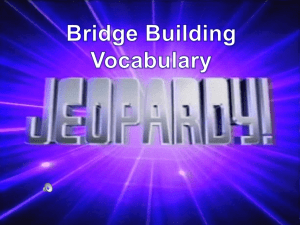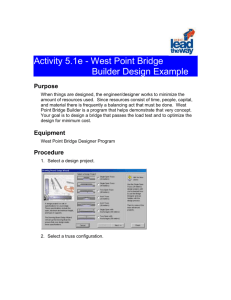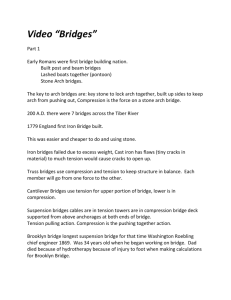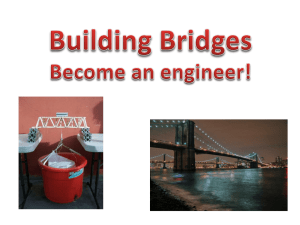The Suspension Bridge
advertisement
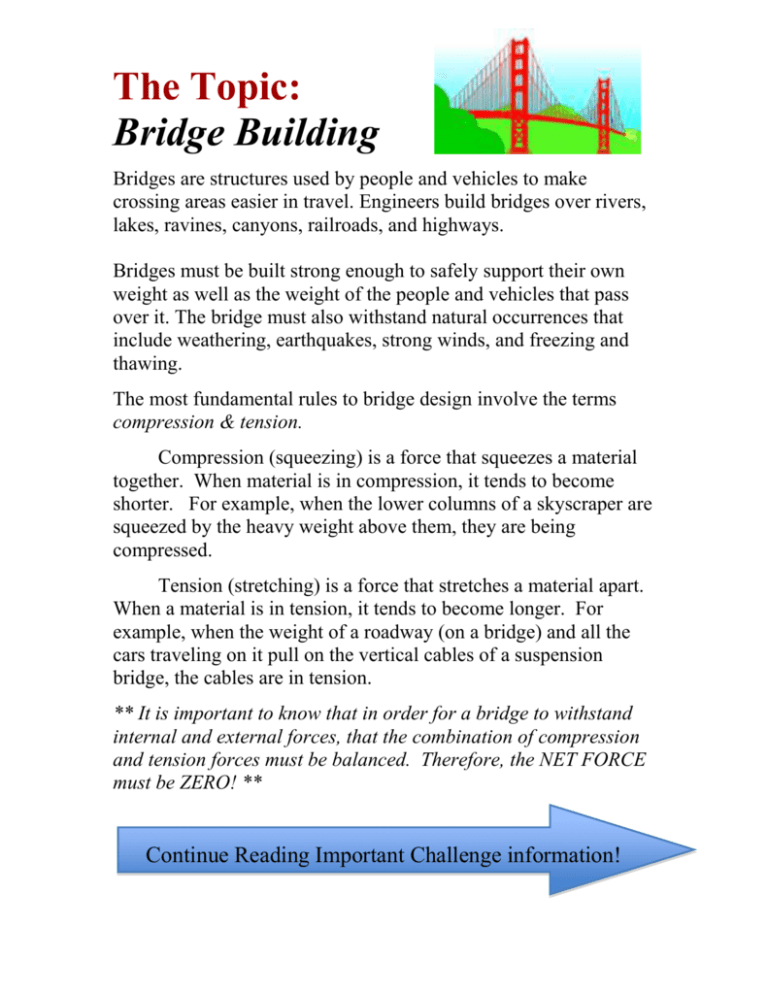
The Topic: Bridge Building Bridges are structures used by people and vehicles to make crossing areas easier in travel. Engineers build bridges over rivers, lakes, ravines, canyons, railroads, and highways. Bridges must be built strong enough to safely support their own weight as well as the weight of the people and vehicles that pass over it. The bridge must also withstand natural occurrences that include weathering, earthquakes, strong winds, and freezing and thawing. The most fundamental rules to bridge design involve the terms compression & tension. Compression (squeezing) is a force that squeezes a material together. When material is in compression, it tends to become shorter. For example, when the lower columns of a skyscraper are squeezed by the heavy weight above them, they are being compressed. Tension (stretching) is a force that stretches a material apart. When a material is in tension, it tends to become longer. For example, when the weight of a roadway (on a bridge) and all the cars traveling on it pull on the vertical cables of a suspension bridge, the cables are in tension. ** It is important to know that in order for a bridge to withstand internal and external forces, that the combination of compression and tension forces must be balanced. Therefore, the NET FORCE must be ZERO! ** Continue Reading Important Challenge information! The Topic: The Inverted Triangle When designing bridges using a truss it becomes clear that the triangle’s shape is strong. Take a look at the diagram above and to the right. The inverted triangle can withstand heavy loads by temporarily “collapsing” into a parallelogram in order to help disperse the weight of the heavy load that is being placed on that area of the bridge. As the weight of the load moves across the bridge the subsequent inverted triangles take on that load. Then the original triangles rebound back to their original shape. Take a CLOSE LOOK at the short video clip that discusses these forces. Train Truss Animation Inverted Triangle Apply light finger pressure at both points. tension member compression members supporting surface When you apply the pressure to the ends of this inverted triangle, it changes shape to accommodate the load placed upon it. If you will, it temporarily collapses into a parallelogram of sorts and can now withstand the forces imposed. The triangle is a flexible shape that will help to withstand the forces of compression and tension. That is one reason bridge design includes trusses like those shown to the right. compression members The Topic: Truss Strength Truss Strength A single beam spanning any distance experiences compression and tension. The very top of the beam experiences the most compression, and the very bottom of the beam experiences the most tension. The middle of the beam experiences very little compression or tension. If the beam were designed so that there was more material on the top and bottom, and less in the middle, it would be better able to handle the forces of compression and tension. (For this reason, I-beams are more rigid than simple rectangular beams.) A truss system takes this concept one step further. Think of one side of a truss bridge as a single beam. The center of the beam is made up of the diagonal members of the truss, while the top and bottom of the truss represent the top and bottom of the beam. Looking at a truss in this way, we can see that the top and bottom of the beam contain more material than its center (corrugated cardboard is very stiff for this reason). In addition to the above-mentioned effect of a truss system, there is another reason why a truss is more rigid than a single beam: A truss has the ability to dissipate a load through the truss work. The design of a truss, which is usually a variant of a triangle, creates both a very rigid structure and one that transfers the load from a single point to a considerably wider area. The Topic: Bridge Basics! The Basics There are three major types of bridges: The beam bridge The arch bridge The suspension bridge The biggest difference between the three is the distances they can cross in a single span. A span is the distance between two bridge supports, whether they are columns, towers or the wall of a canyon. A modern beam bridge, for instance, is likely to span a distance of up to 200 feet (60 meters), while a modern arch can safely span up to 800 or 1,000 feet (240 to 300 m). A suspension bridge, the pinnacle of bridge technology, is capable of spanning up to 7,000 feet (2,100 m). What allows an arch bridge to span greater distances than a beam bridge, or a suspension bridge to span a distance seven times that of an arch bridge? The answer lies in how each bridge type deals with two important forces called compression and tension: Compression is a force that acts to compress or shorten the thing it is acting on. Tension is a force that acts to expand or lengthen the thing it is acting on. A simple, everyday example of compression and tension is a spring. When we press down, or push the two ends of the spring together, we compress it. The force of compression shortens the spring. When we pull up, or pull apart the two ends, we create tension in the spring. The force of tension lengthens the spring. Compression and tension are present in all bridges, and it's the job of the bridge design to handle these forces without buckling or snapping. Buckling is what happens when the force of compression overcomes an object's ability to handle compression, and snapping is what happens when the force of tension overcomes an object's ability to handle tension. The best way to deal with these forces is to either dissipate them or transfer them. To dissipate force is to spread it out over a greater area, so that no one spot has to bear the brunt of the concentrated force. To transfer force is to move it from an area of weakness to an area of strength, an area designed to handle the force. An arch bridge is a good example of dissipation, while a suspension bridge is a good example of transference. The Topic: Three Basic Bridge Types The Beam Bridge A beam bridge is basically a rigid horizontal structure that is resting on two piers, one at each end. The weight of the bridge, and any traffic on it, is directly supported by the piers. The weight is traveling directly downward. The force of compression manifests itself on the top side of the beam bridge's deck (or roadway). This causes the upper portion of the deck to shorten. The result of the compression on the upper portion of the deck causes tension in the lower portion of the deck. This tension causes the lower portion of the beam to lengthen. Take a two-by-four and place it on top of two empty milk crates -- you've just created a crude beam bridge. Now place a 50-pound weight in the middle of it. Notice how the two-by-four bends. The top side is under compression and the bottom side is under tension. If you keep adding weight, eventually the two-by-four will break. Actually, the top side will buckle and the bottom side will snap. Many beam bridges that you find on highway overpasses use concrete or steel beams to handle the load. The size of the beam, and in particular the height of the beam, controls the distance that the beam can span. By increasing the height of the beam, the beam has more material to dissipate the tension. To create very tall beams, bridge designers add supporting lattice work, or a truss, to the bridge's beam. This support truss adds rigidity to the existing beam, greatly increasing its ability to dissipate the compression and tension. Once the beam begins to compress, the force is dissipated through the truss. Despite the ingenious addition of a truss, the beam bridge is still limited in the distance it can span. As the distance increases, the size of the truss must also increase, until it reaches a point where the bridge's own weight is so large that the truss cannot support it. The Arch Bridge An arch bridge is a semicircular structure with abutments on each end. The design of the arch, the semicircle, naturally diverts the weight from the bridge deck to the abutments. Arch bridges are always under compression. The force of compression is pushed outward along the curve of the arch toward the abutments. The tension in an arch is negligible. The natural curve of the arch and its ability to dissipate the force outward greatly reduces the effects of tension on the underside of the arch. The greater the degree of curvature, (the larger the semicircle of the arch) however, the greater the effects of tension on the underside to effectively dissipate (spread out) the weight from the center of the deck to the abutments. As with the beam bridge, the limits of size will eventually overtake the natural strength of the arch. The shape of the arch itself is all that is needed. The Suspension Bridge A suspension bridge is one where cables (or ropes or chains) are strung across the river (or whatever the obstacle happens to be) and the deck is suspended from these cables. Modern suspension bridges have two tall towers through which the cables are strung. Thus, the towers are supporting the majority of the roadway's weight. The force of compression pushes down on the suspension bridge's deck, but because it is a suspended roadway, the cables transfer the compression to the towers, which dissipate the compression directly into the earth where they are firmly entrenched. The supporting cables, running between the two anchorages, are the lucky recipients of the tension forces. The cables are literally stretched from the weight of the bridge and its traffic as they run from anchorage to anchorage. The anchorages are also under tension, but since they, like the towers, are held firmly to the earth, the tension they experience is dissipated. Almost all suspension bridges have, in addition to the cables, a supporting truss system beneath the bridge deck (a deck truss). This helps to stiffen the deck and reduce the tendency of the roadway to sway and ripple.

